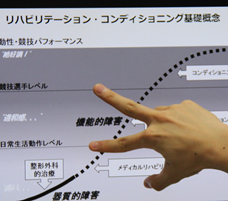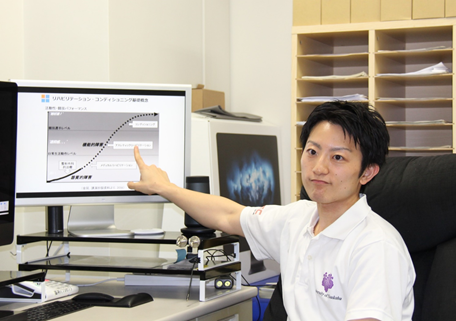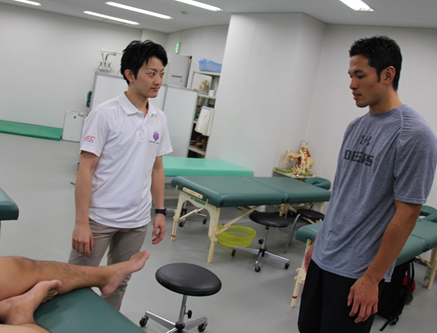TSUKUBA FUTURE
#096 Reaching for the Heights as an Athletic Trainer
Junior Assistant Professor WARASHINA Yuki, Faculty of Health and Sport Sciences

Injuries are an inevitable part of sports, but athletes cannot simply continue while enduring pain and training on their own. The job of a trainer is to provide proper support and guidance so an injured athlete can quickly return to or improve their original competitive level, and to prevent recurrence of the same injury. A trainer educates athletes to practice injury prevention techniques on their own, and offers support suited to individual needs. To do that, he or she must have a wide range of knowledge and skills, on everything from the special characteristics of each sport, to the structure of the body and psychological aspects.

When a bone fracture, dislocation, or other injury occurs, the first step is medical treatment— involving surgery or other care—followed by medical rehabilitation to restore the original movement ability. Normally, that is enough, but for an athlete, the original level before the injury is completely different. To restore the ability to perform at the previous level, or even higher, requires athletic rehabilitation, including specialized training that goes a step beyond ordinary training. As an athletic trainer in charge of such tasks, Prof. Warashina provides support to many athletes, and educates younger students in the graduate school who want to become trainers.
At the Trainer Clinic of the Sport Performance and Clinic Laboratory of the University of Tsukuba, not only do athletes from the university visit for athletic rehabilitation, top athletes from outside the university sometimes come by for training, too. In the field of medical rehabilitation, there are protocols (standard methods) suited to different parts of the body, types of injuries, and so on. Prof. Warashina first interacts with athletes in accordance with these protocols. His main guiding principle is to proceed according to a protocol, while paying close attention to individual needs. If these points are ignored, recovery will not go well, and repeated injuries will occur. After the athlete can carry out the movements of ordinary life, the next step is athletic rehabilitation. This involves step-by-step training to return the athlete to competition.
Due to the development of sport sciences, elite athletes in all sports are attended by teams of support staff, including doctors, trainers, coaches, nutritionists, and pharmacists. Although, it is the athlete who competes, it is the strength of the team that provides a foundation to support the athlete's performance. The trainer's role within a team is to provide first aid in case of an injury, encourage proper training, and offer support to rebuild the body so the athlete can return to competition as smoothly as possible after injury treatment and basic rehabilitation. The trainer performs massage and stretching, carefully explains the status of the injury to the athlete, ascertains and provides guidance on when, what, and how much training should be done, while also taking into account the competition schedule. In addition to understanding and respecting athletes, it is essential for trainers to have specialized knowledge, physical strength to move together with athletes, the ability to share the athletes' sense of movement, and skill with words.
As an active badminton player himself, Prof. Warashina has experienced injuries and surgery. He is also active as a para-badminton trainer and coach. From the perspective of training to prevent injury, he says that research on the sport of badminton is not very advanced compared to other sports. Previously, for example, although many players had shoulder pain, the reality was that they did not receive proper diagnosis and therapy, and each player dealt with it in their own way. Shoulder pain occurs in all sorts of sports, but the way the body moves is different in each sport, and thus there are differences in the cause of pain and the method of dealing with it. Prof. Warashina has studied the distinctive characteristics of the movement of the shoulder in badminton, and determined the mechanisms of pain that stem from that. Based on this, he also proposes methods of prevention and improvement.
Athletes who experience no injuries at all are very rare, but there are some who are infrequently injured. This is due not just to a lot of strenuous practice; it is result of their good understanding of the body's mechanisms, and their attention to managing their physical condition so they do not push themselves too hard, as well as preventive training and recovery strategies. However, in club activities in junior and senior high school, there are almost no opportunities to learn about such things. Many of the students instructed by Prof. Warashina go to work in coaching or guidance positions on the front lines of education or sports. Therefore, he expects there will be an increasing number of coaches with trainer knowledge working in education. He believes they will become leaders in their communities, and good supporters of the athletes doing their best in sports.
Prof. Warashina was led down the path to becoming a trainer through his study on how to manage his own body as an athlete. He focuses on two points as a trainer: valuing the intuition of athletes while stressing evidence, and providing support as someone who can move together with athletes as a physical education specialist, offering model words and actions. Individually, he says his goal is to continue as an active badminton player, and win a gold medal in the 65 and over singles class at the Senior Badminton Championships.


Step-by-step rehabilitation and training are necessary to return to competition from an injury
Prof. Warashina is passionate about practical guidance for students aiming to become trainers
Article by Science Communicator at the Office of Public Relations


